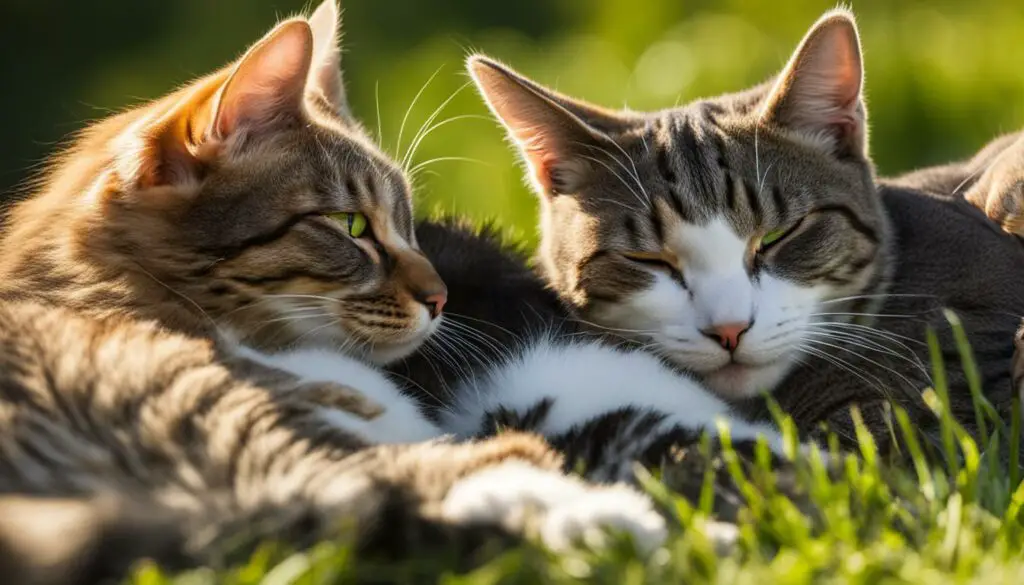As a cat lover, I have often wondered whether male cats get along with each other. It’s an intriguing subject that has sparked many discussions among pet owners. So, I decided to delve deeper into the behavior of male cats and shed some light on the topic.
Male cats are often known for their independent and territorial nature, leading some to believe that they may not be as sociable as female cats. However, scientific studies have revealed that a male cat’s behavior is not determined by its gender, but rather by the level of socialization and engagement it receives from its owner.
While male cats are not inherently more or less affectionate than female cats, their behavior can be influenced by certain factors. Neutering, for example, can help reduce aggressive behavior and roaming tendencies in male cats, promoting a more harmonious living environment.
Key Takeaways:
- Male cats can be just as affectionate as female cats towards their human companions.
- Behavior is not determined by gender but by socialization and engagement.
- Neutering can reduce aggressive behavior and roaming in male cats.
- The gender of the owner can have an impact on the cat-human bond.
- Understanding a cat’s body language and respecting their boundaries can strengthen the bond between a cat and their owner.
The Influence of Gender on Cat Personality and Affection
When it comes to cat personality and affection, gender plays a minimal role. Scientific studies have shown that both male and female cats can be equally loving and affectionate towards their owners. It is important to note that a cat’s behavior is primarily influenced by their level of socialization and engagement with their human companions, rather than their gender.
While male cats are not inherently more or less affectionate than female cats, the gender of the owner can have an impact on the cat-human bond. Female owners are often more active and engaged with their cats, which may result in a stronger bond compared to male owners. However, this does not mean that male owners cannot form deep and loving relationships with their male cats.
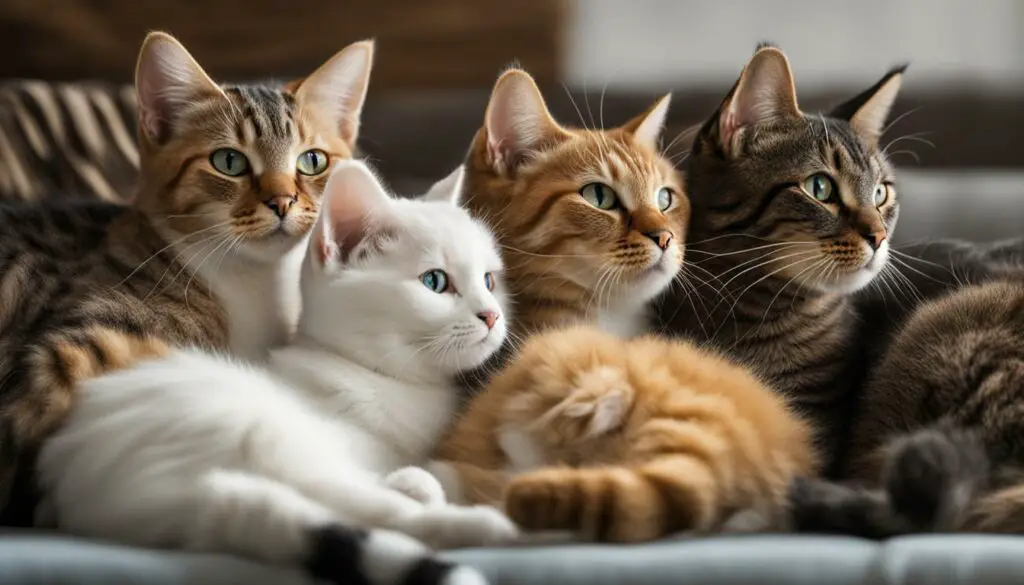
Neutering is an important consideration when it comes to male cat behavior. Neutering can help reduce aggressive behavior and roaming tendencies in male cats. It is recommended to have male cats neutered to promote their overall well-being and prevent any unwanted behavioral issues. Neutered male cats are generally calmer and less prone to engaging in territorial disputes or fights with other cats.
Overall, the gender of a cat does not determine their personality or affectionate nature. Both male and female cats can form loving bonds with their owners, and the level of socialization and engagement they receive is more influential than their gender. By providing a nurturing environment, meeting their individual needs, and using effective bonding techniques, male cats can thrive in multi-cat households and enjoy harmonious relationships with their feline companions.
Factors Influencing a Cat’s Affectionate Behavior
Understanding the factors that influence a cat’s affectionate behavior is key to building a strong and loving bond with your feline companion. From socialization to creating a nurturing environment, there are several aspects to consider when it comes to fostering affection in cats.
One of the most important factors is early socialization. Kittens that are properly socialized and exposed to different people and environments from a young age tend to be friendlier and more open to forming bonds. This early socialization helps them become comfortable with human interaction and develop positive associations with people.
Rescued or fostered cats may require extra patience and compassion. These cats may have had negative experiences in the past, which can affect their ability to trust and bond with humans. Creating a safe and calm environment for them, with plenty of positive reinforcement and gradual introductions, can help them overcome their fears and build trust.
Understanding Cat Body Language
H3: Understanding cat body language is crucial for enhancing the bond between you and your cat. Cats communicate through subtle cues, and being able to interpret these signals can help you better understand their needs and boundaries. Some common expressions of affection in cats include purring, kneading, and rubbing their bodies against you. However, it’s important to remember that each cat is unique, and their body language may vary. Pay attention to their tail position, ear movement, and overall posture to gauge their level of comfort and affection.
| Factors Influencing a Cat’s Affectionate Behavior | Description |
|---|---|
| Early socialization | Kittens that are properly socialized from a young age tend to be friendlier and more receptive to forming bonds with humans. |
| Rescued or fostered cats | Cats that have had negative experiences in the past may require extra patience and compassion to build trust and form a bond. |
| Understanding cat body language | Being able to interpret a cat’s body language helps in understanding their needs, boundaries, and level of comfort and affection. |
| Respecting boundaries | Each cat has its own boundaries, and respecting these boundaries is essential for fostering a positive and affectionate relationship. |
Respecting a cat’s boundaries is also crucial. Just like humans, cats have their own personal space and comfort zones. It’s important to give them the freedom to approach and interact with you on their terms. Avoid forcing physical contact or overwhelming them with excessive attention, as this can create stress and anxiety. Instead, let them come to you and initiate affectionate interactions.
By understanding the factors that influence a cat’s affectionate behavior and respecting their individual needs, you can create a strong bond based on trust and mutual understanding. Remember, building a loving relationship with your cat takes time and patience, but the rewards are well worth the effort.
Introducing Male Cats for Compatibility and Companionship
When it comes to introducing male cats for compatibility and companionship, a gradual and planned approach is key. Male cats, just like any other cats, have unique personalities and may require time to adjust to each other’s presence. By following a few guidelines and observing their behavior, you can help foster a positive and harmonious relationship between your male cats.
Creating a Safe and Neutral Territory
Before introducing your male cats, establish a safe and neutral territory where both cats can feel comfortable. This can be a separate room that is free of any strong scents or traces of other cats. Provide each cat with their own food, water, litter box, and bedding. Gradually introduce their scents to each other by swapping bedding and rubbing a cloth on one cat’s face and then allowing the other cat to sniff it. This will help them become familiar with each other’s scent.
Gradual Face-to-Face Introductions
Once they have become accustomed to each other’s scent, you can begin face-to-face introductions. However, it’s important to do this gradually and under controlled circumstances. Begin by placing a baby gate or a screen door between the cats, allowing them to see each other without physical contact. Monitor their behavior for signs of aggression, such as hissing or growling. If their initial encounters go well, you can gradually increase their interaction time and remove the barrier.
Equal Resources and Positive Reinforcement
To prevent resource guarding and potential conflicts, it’s crucial to provide equal access to essential resources. Each cat should have their own food and water bowls, litter boxes, scratching posts, and resting areas. Positive reinforcement, such as treats and praise, can also help create a positive association between the cats during their interactions. Reward them for calm and friendly behavior, and redirect any signs of aggression or tension.
| Introducing Male Cats for Compatibility and Companionship | |
|---|---|
| 1. Create a safe and neutral territory | Provide separate spaces with their own resources |
| 2. Gradual face-to-face introductions | Start with a barrier and monitor for signs of aggression |
| 3. Equal resources and positive reinforcement | Ensure each cat has access to essential resources and reward calm behavior |
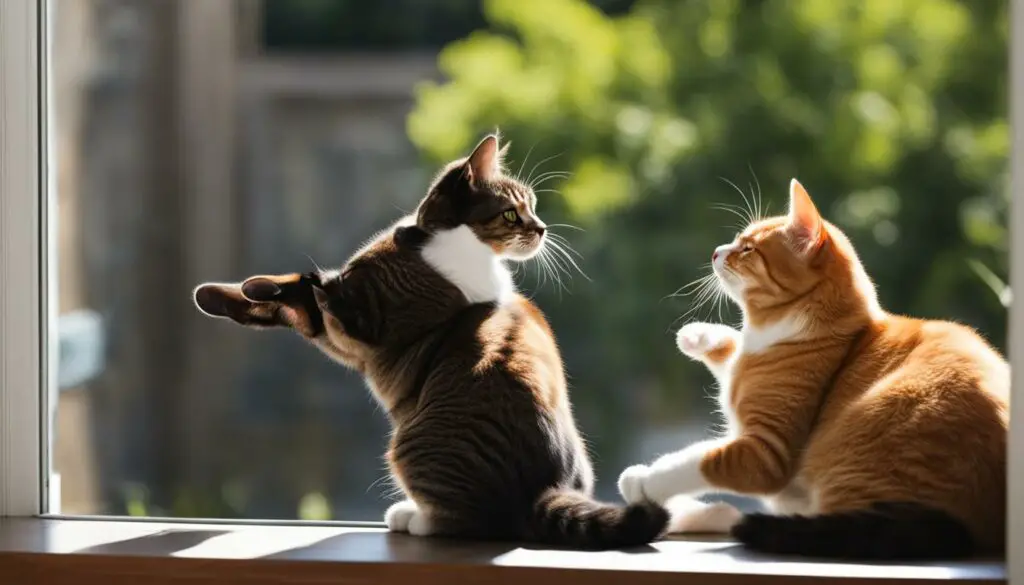
Understanding Territorial Behavior and Aggression in Male Cats
Male cats are known for their territorial behavior, which can sometimes lead to aggression towards other cats. It’s important for cat owners to understand these behaviors and take steps to minimize conflicts and promote a harmonious living environment for their feline companions.
Male cats mark their territory by spraying urine and scratching objects. This territorial marking is a way for them to establish their dominance and communicate with other cats. However, it can be a source of conflict when multiple male cats are present in the same household.
Aggression in male cats can manifest in various ways, including hissing, growling, and fighting. It’s crucial for cat owners to be able to recognize the signs of aggression and take appropriate measures to prevent conflicts. Neutering male cats can help reduce territorial aggression and roaming tendencies, making them less likely to engage in aggressive behaviors.
Understanding the dynamics of dominance and hierarchy within a multi-cat household is essential. By providing separate spaces, resources, and territories for each cat, owners can minimize the need for territorial disputes. Observing the cats’ body language and intervening when necessary can also help prevent conflicts and ensure a peaceful coexistence.
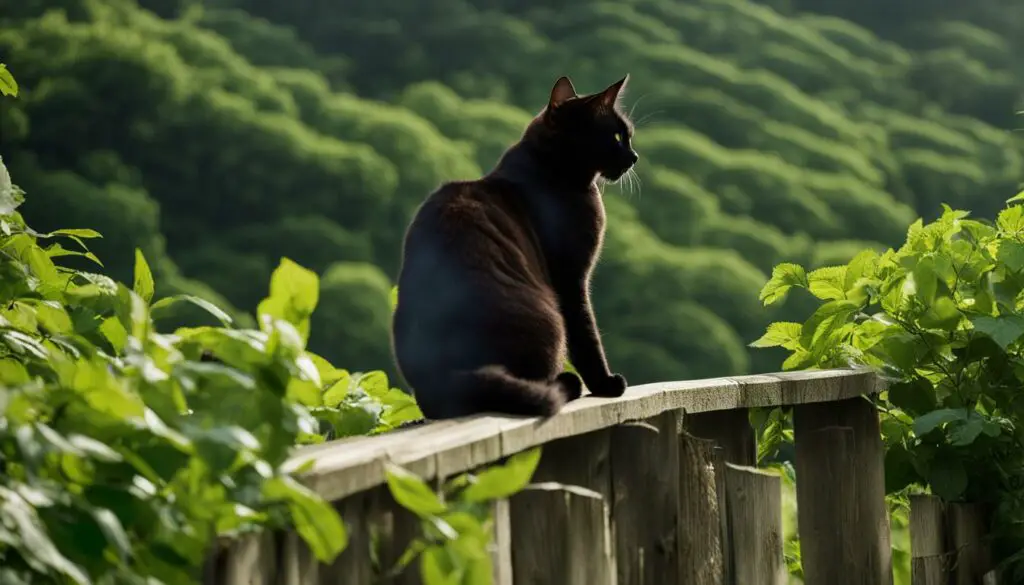
Table: Signs of Aggression in Male Cats
| Behavior | Description |
|---|---|
| Hissing | The cat produces a loud hissing sound as a warning. |
| Growling | The cat emits a low, deep growl to express anger or threat. |
| Chasing | The cat pursues and chases another cat aggressively. |
| Swatting | The cat uses its paw to strike another cat in an aggressive manner. |
By understanding the territorial behavior and aggression in male cats, cat owners can create a peaceful and harmonious environment for their furry friends. Neutering, providing separate spaces, and recognizing the signs of aggression are all important steps towards fostering positive relationships among male cats in a multi-cat household.
Using Tools and Techniques for Bonding and Harmony
Bonding and fostering harmony between male cats is essential for creating a peaceful and enriching environment for them. There are several tools and techniques that can aid in strengthening their bond and promoting positive interactions. From catnip to grooming, here are some effective methods:
1. Catnip:
Catnip is a herb that stimulates cats and can create a positive and playful environment. Many cats are attracted to the scent of catnip, and it can be used as a tool to engage and bond with male cats. Simply sprinkle a small amount of catnip on toys or scratching posts to encourage them to play and explore.
2. Pheromones:
Pheromones are chemical substances that cats use to communicate and establish a sense of security. Synthetic feline pheromones, available in diffusers, sprays, or collars, can help create a calming atmosphere and reduce stress for male cats. These pheromones mimic the natural scents that cats produce and can promote a sense of relaxation and bonding.
3. Regular Grooming Sessions:
Grooming is an excellent bonding activity between cats and their owners. By regularly brushing your male cats, you can strengthen your bond and create a positive association with touch. Grooming also helps maintain healthy fur and skin, preventing matting and skin issues. Remember to use gentle strokes and make grooming sessions a pleasant experience for both you and your cat.
4. Interactive Playtime:
Interactive play sessions are crucial for stimulating a male cat’s mind and body. Engaging them in play helps release excess energy and encourages socialization. Use interactive toys such as wand teasers, laser pointers, or treat puzzle toys to keep them entertained and active. By participating in play sessions, you can create positive experiences and build a strong bond with your male cats.
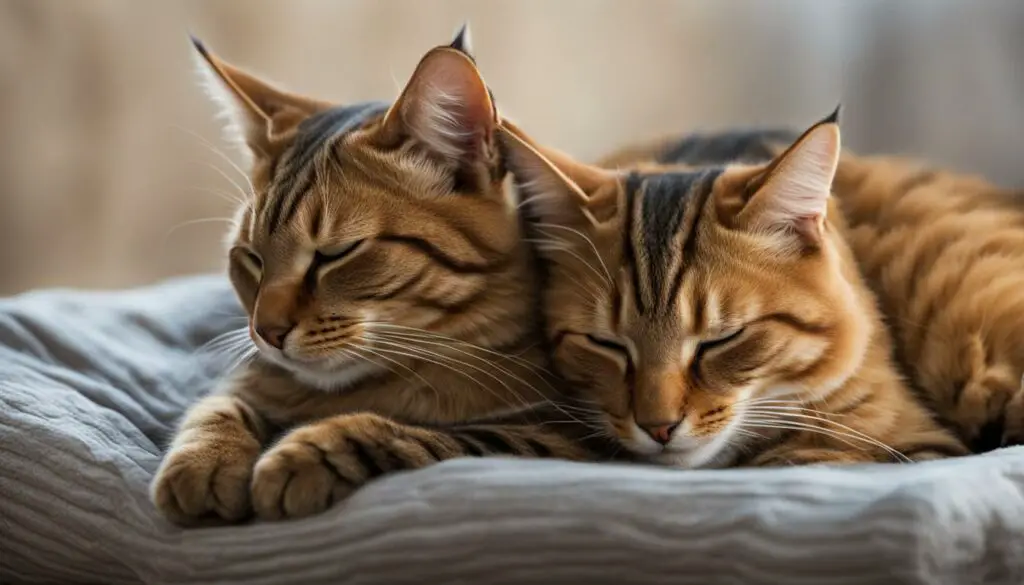
Using these tools and techniques can contribute to creating a harmonious and joyful environment for male cats. By incorporating catnip, pheromones, regular grooming sessions, and interactive playtime into your routine, you can foster bonding, reduce stress, and promote positive interactions between your male cats.
The Role of Scent and Territory in Male Cat Relationships
When it comes to male cat relationships, scent and territory play a crucial role in establishing and maintaining their dynamics. Cats use scent marking as a way to communicate and define their territory. This behavior helps them feel secure and in control of their surroundings. By understanding and respecting these natural instincts, we can promote harmony and minimize conflicts between male cats.
Scent marking is a form of communication among cats. They use glands in their paws, cheeks, and tails to leave scent marks on objects in their territory. This marking serves as a signal to other cats, conveying messages such as territorial boundaries, mating availability, and social status. It’s important to note that scent marking is not a sign of aggression; rather, it is a natural behavior for male cats to establish their presence.
To encourage positive male cat relationships, it’s essential to create an environment that allows for territory sharing. This can be achieved by gradually introducing new scents and providing spaces where cats can comfortably coexist. Separate areas for each cat, including food bowls, litter boxes, and resting spots, help reduce the need to assert dominance and minimizes territorial disputes. By respecting each cat’s individual space and ensuring equal access to resources, we can foster a sense of acceptance and minimize conflicts.
The Importance of Scent Exchange
One effective way to promote positive male cat relationships is through scent exchange. This process involves introducing scents from one cat to another gradually. This can be done by using a cloth or towel to rub the scent from one cat’s facial area and then transferring it to the other cat. This promotes familiarity and allows the cats to recognize each other’s scents, establishing a sense of acceptance and bonding.
| Scent Exchange Techniques | Benefits |
|---|---|
| Scent swapping using a cloth or towel | Promotes familiarity and acceptance |
| Shared bedding | Allows cats to exchange scents and create a common scent profile |
| Interactive play sessions with shared toys | Facilitates positive experiences and encourages social bonding |
Remember, patience is key when introducing male cats. It may take time for them to adjust to each other’s scents and establish a comfortable relationship. Supervise their interactions initially and provide positive reinforcement for calm and peaceful behavior. With proper scent exchange and territory sharing, male cats can develop harmonious relationships and enjoy companionship with their feline peers.

Understanding the Dynamics of Male-Male and Male-Female Relationships
Male cats have the ability to form social bonds and establish relationships with other cats, regardless of their gender. The dynamics of these relationships can vary depending on various factors, including individual personalities, socialization, and environmental conditions. It is important for cat owners to understand and respect the unique dynamics that exist between male cats to promote harmonious interactions and companionship.
When it comes to male-male relationships, it is not uncommon for cats to establish a hierarchy or pecking order. This hierarchy helps to establish boundaries and maintain order within the group. Male cats may engage in dominance displays and assert their position within the social structure. By allowing the cats to establish their own hierarchy and respecting their individual boundaries, owners can facilitate a positive male-male relationship.
On the other hand, male-female relationships can range from companionship to potential mating behavior. Male cats may form strong bonds with female cats, seeking their companionship and forming a social connection. However, it is important to note that not all male-female relationships are driven by mating instincts. Cats can develop deep and meaningful connections with each other based on companionship and mutual respect.
“Male cats have the ability to form social bonds and establish relationships with other cats, regardless of their gender.”
In both male-male and male-female relationships, social bonding plays a crucial role. Cats are social animals and thrive on companionship. By providing opportunities for socialization and play, owners can help foster positive relationships between male cats. Engaging in interactive play sessions, grooming each other, and spending quality time together can strengthen the bond and create a sense of camaraderie.
Understanding the dynamics of male-male and male-female relationships involves recognizing and respecting each cat’s individual needs, preferences, and boundaries. By providing a nurturing environment, facilitating positive interactions, and applying effective bonding techniques, cat owners can help foster harmonious relationships and create a peaceful living environment for their feline companions.
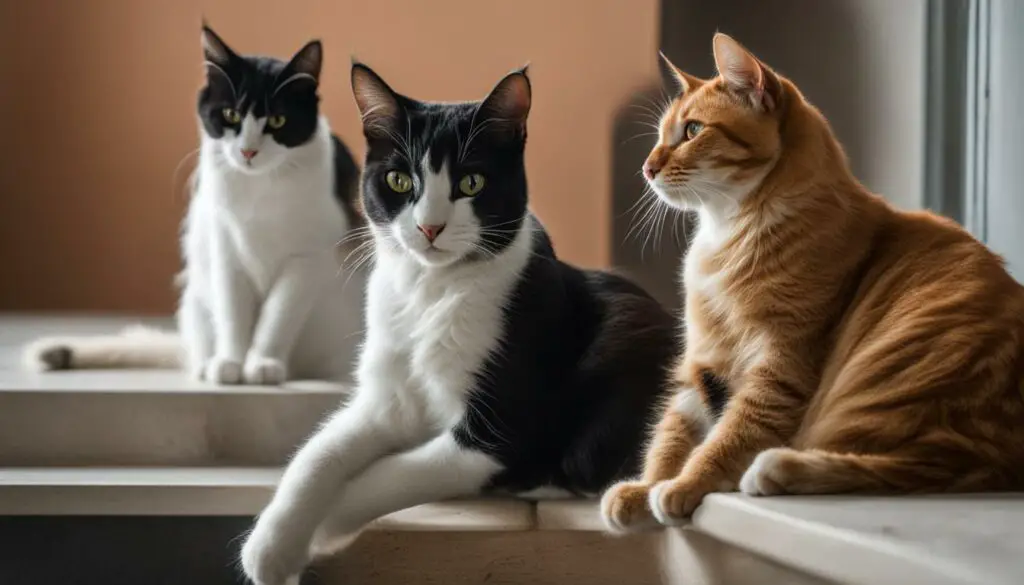
The Impact of Neutering on Male Cat Behavior
Neutering male cats can have a significant impact on their behavior. It is a surgical procedure that removes the testicles, which plays a vital role in reducing aggressive behavior, territorial marking, and roaming tendencies in male cats. When a male cat is neutered, the production of testosterone is significantly decreased, leading to calmer and less aggressive behavior. This reduction in hormone levels helps in minimizing the chances of engaging in territorial disputes or fights with other cats.
Aggression is a common issue among male cats, especially when establishing dominance or protecting their territory. By neutering them, their territorial instincts are generally lessened, resulting in a more peaceful and harmonious living environment. Neutering also helps in preventing unwanted behaviors such as spraying urine to mark their territory. This behavior can be quite challenging to manage, as the strong odor can be difficult to remove and may damage furniture or walls.
Roaming is another behavior that is often seen in intact male cats who are searching for a mate. They tend to wander away from home in search of a female cat in heat, which can lead to various risks such as getting lost, injured, or involved in fights with other males. Neutering significantly reduces this roaming behavior as the male cat’s desire to mate is decreased. It helps in keeping the cats safe and preventing unwanted litters.
| Behavior | Neutered Male Cats | Intact Male Cats |
|---|---|---|
| Aggression | Reduced | More likely to exhibit aggressive behavior |
| Territorial Marking | Less likely to engage in marking behavior | More likely to spray urine to mark territory |
| Roaming | Less likely to wander away from home | More likely to roam in search of a mate |
Neutering male cats is not only beneficial for their behavior but also for their overall well-being. It reduces the risk of certain health issues, such as testicular cancer and urinary tract infections. Additionally, neutering helps in controlling the cat population by preventing unwanted pregnancies. It is recommended by veterinarians to neuter male cats at an early age to promote their overall health and prevent unwanted behaviors.
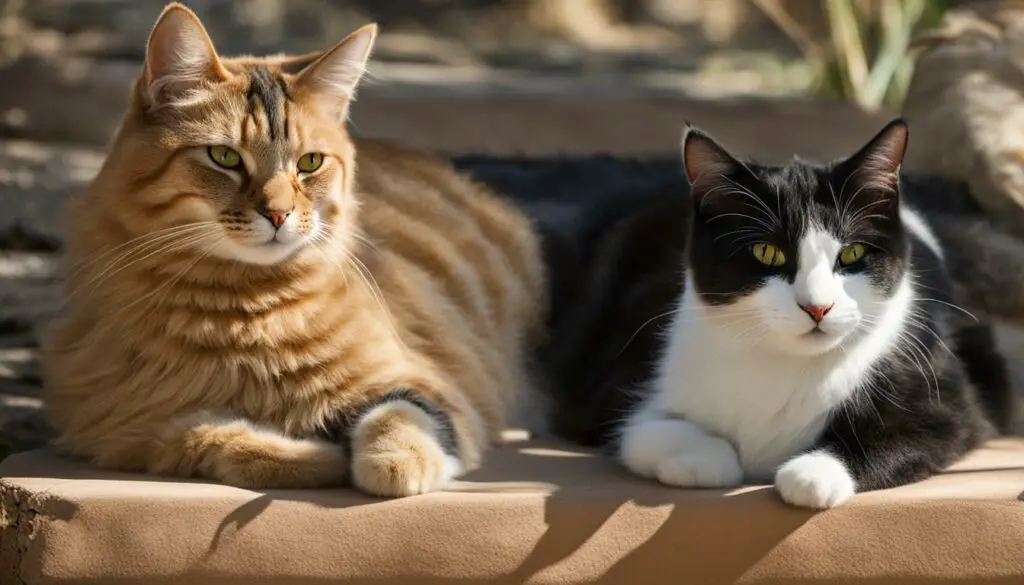
Tips for Creating a Multi-Cat Household
Creating a harmonious multi-cat household requires careful planning and consideration to ensure that all cats coexist peacefully. Here are some tips to help you create a positive living environment for multiple cats:
- Proper Introductions: When introducing new cats to your household, it’s important to do so gradually. Start by keeping the new cat in a separate room, allowing the cats to sniff each other under the door and get used to each other’s scents. Over time, you can gradually increase their interaction and supervised playtime.
- Separate Spaces: Each cat should have their own space where they can retreat to when they need some alone time. This can be a separate room or designated areas within your home where they can go to relax and feel safe.
- Equal Resources: Ensure that each cat has access to their own food bowls, water bowls, litter boxes, and scratching posts. Having equal resources can prevent conflict and reduce competition among the cats.
- Social Interaction and Play: Cats are social animals, and providing opportunities for social interaction and play can help strengthen their bond and reduce conflicts. Engage them in interactive play sessions and provide plenty of toys that they can enjoy together.
Remember, each cat is unique, and it may take time for them to adjust to living with other cats. Be patient, observe their behavior, and intervene when necessary to prevent conflicts. By following these tips and providing a nurturing environment, you can create a multi-cat household where all cats can cohabitate in harmony.
Table: Tips for Creating a Multi-Cat Household
| Tips |
|---|
| Proper Introductions |
| Separate Spaces |
| Equal Resources |
| Social Interaction and Play |
Creating a successful multi-cat household requires patience, understanding, and a commitment to providing each cat with their own space and resources. With proper introductions, separate spaces, equal resources, and opportunities for social interaction, you can create a harmonious living environment where all cats can coexist happily.
“Cats are independent, but they also crave companionship and social interaction. By following these tips, you can create a multi-cat household that promotes peace and harmony among your feline companions.” – Cat Lover
Gender Dynamics in Cat Relationships
When it comes to cat relationships, gender dynamics play a fascinating role in shaping interactions and compatibility. Male cats can form bonds with both male and female cats, but the nature of these relationships may vary. Understanding the dynamics of male cat relationships is essential for creating a harmonious multi-cat household.
While individual personalities and socialization strongly influence compatibility, male-male relationships often involve establishing a hierarchy or pecking order. Cats may engage in dominance displays, such as posturing, hissing, and chasing, as they establish their roles within the group. On the other hand, male-female relationships can range from companionship to potential mating behavior, depending on the cats involved.
Creating a nurturing environment that respects the unique dynamics of each cat’s relationships is crucial. Providing separate spaces and resources for each cat can help minimize territorial conflicts. Observing their body language and intervening if signs of aggression or conflict arise is essential. By fostering positive interactions through regular engagement, play, and positive reinforcement, male cats can thrive and enjoy harmonious relationships in a multi-cat household.
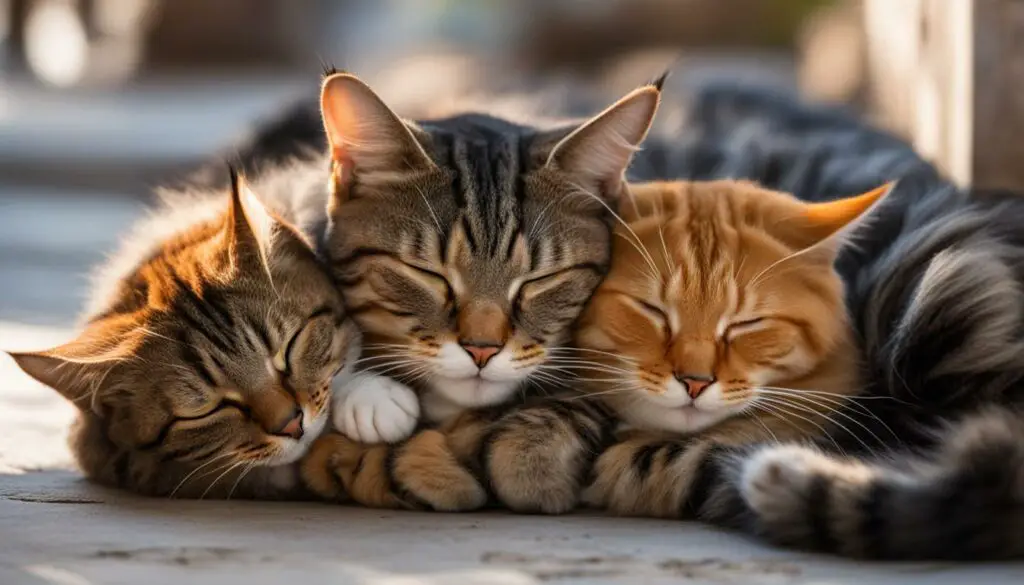
Table: Examples of Male Cat Relationship Dynamics
| Relationship | Description |
|---|---|
| Male-Male | Establishing hierarchy through dominance displays and posturing |
| Male-Female | Ranging from companionship to potential mating behavior |
| Male-Male-Female | Combination of hierarchy establishment and potential mating behavior |
| Male-Male Siblings | Development of strong bonds and cooperative behavior |
Understanding the gender dynamics in cat relationships allows cat owners to provide the necessary support and environment for positive interactions and companionship. By recognizing and respecting the unique dynamics of each relationship, cat owners can ensure a harmonious and enjoyable living environment for their feline companions.
How to Foster Positive Male Cat Relationships
When it comes to male cat socialization, companionship, and aggression, there are several strategies that can help foster positive relationships. It all starts with early socialization, which is crucial in shaping the behavior of male cats. By exposing them to different people, environments, and other cats at a young age, they can develop friendly and sociable behavior.
When introducing male cats to each other, it’s important to do so gradually and carefully. Monitor their interactions closely and intervene if any signs of aggression or conflict arise. Providing separate spaces during the initial introduction phase can also help minimize tension and allow each cat to adjust to the presence of the other.
Building a strong bond between male cats involves regular engagement, play, and positive reinforcement. Interactive play sessions not only provide an outlet for their energy but also create opportunities for socialization. Additionally, grooming sessions can strengthen the bond between cats and promote a sense of trust and companionship.
Table: Tips for Fostering Positive Male Cat Relationships
| Tips | Description |
|---|---|
| Early socialization | Expose male cats to various people, environments, and cats at a young age. |
| Gradual introductions | Introduce male cats to each other slowly, monitoring their interactions closely. |
| Separate spaces | Provide separate spaces during the initial introduction phase to minimize tension. |
| Regular engagement | Engage in interactive play sessions to provide socialization opportunities. |
| Positive reinforcement | Use positive reinforcement techniques to reward desired behaviors and strengthen the bond. |
| Grooming sessions | Regular grooming sessions can help build trust and promote companionship. |
Remember, every cat is unique, and their relationships may vary based on individual personalities, socialization, and environmental factors. By implementing these strategies and tailoring them to your specific cats’ needs, you can foster positive male cat relationships and create a harmonious living environment for all.

Section 13: Conclusion
After a closer look at the subject, it is clear that male cats can indeed get along with other cats and form strong bonds of compatibility and companionship. While their behavior is not determined by gender, it is influenced by factors such as socialization, interaction, and environmental conditions.
Understanding the dynamics of male-male and male-female relationships is crucial in creating a harmonious living environment for multiple cats. Proper introductions, separate spaces, and equal access to resources can help prevent conflicts and promote a peaceful cohabitation.
Neutering male cats plays an important role in reducing aggressive behavior and territorial instincts. It is recommended to neuter male cats to ensure their overall well-being and prevent unwanted behavior.
By providing a nurturing environment, meeting their individual needs, and using effective bonding techniques, male cats can thrive in multi-cat households and enjoy harmonious relationships with their feline companions. With patience, understanding, and a little bit of effort, male cats can indeed get along and form lasting friendships.
FAQ
Do male cats get along with other cats?
Yes, male cats can get along with other cats. However, compatibility and harmonious relationships depend on various factors such as socialization, individual personalities, and environmental conditions.
Does the gender of a cat impact their personality and affection?
No, the gender of a cat does not determine their personality or affection. Cat personality is influenced by socialization and interaction, while the gender of the owner can have a greater impact on the cat-human bond.
What factors influence a cat’s affectionate behavior?
A cat’s affectionate behavior is influenced by factors such as early socialization, individual boundaries, and a nurturing environment. Proper socialization and exposure to different people can make kittens friendlier, while rescued or fostered cats may require more patience and compassion to build trust.
How can I introduce male cats for compatibility and companionship?
Introducing male cats requires proper planning and gradual introductions. Different cats have different personalities and may require time to adjust to each other’s presence. Providing equal access to resources and observing their body language can contribute to a positive introduction process.
What should I know about territorial behavior and aggression in male cats?
Male cats exhibit territorial behavior and may display aggression towards other cats, especially when establishing dominance. Neutering can help reduce territorial aggression and roaming tendencies. Understanding the signs of aggression and providing separate spaces for each cat can prevent conflicts.
What tools and techniques can I use for bonding and harmony?
Tools such as catnip, pheromones, grooming sessions, and interactive play can help foster bonding and harmony between male cats. Catnip creates a stimulating environment, pheromones promote relaxation, grooming strengthens the bond, and interactive play provides socialization and energy outlet.
What role does scent and territory play in male cat relationships?
Scent plays a crucial role in male cat relationships. Cats use scent marking to establish and communicate their territory. By gradually introducing new scents and providing separate spaces for each cat, familiarity and acceptance can be promoted while reducing territorial conflicts.
How do male-male and male-female relationships differ in cats?
Male-male relationships often involve establishing a hierarchy or pecking order, while male-female relationships can range from companionship to potential mating behavior. Each relationship dynamic is influenced by individual personalities, socialization, and environmental factors.
Does neutering impact male cat behavior?
Neutering can have a significant impact on male cat behavior. It reduces aggressive behavior, territorial marking, and roaming tendencies. Neutered male cats are generally calmer and less prone to engaging in territorial disputes or fights with other cats.
What are some tips for creating a multi-cat household?
To create a harmonious multi-cat household, proper introductions, separate spaces, and providing equal resources are important. Understanding each cat’s individual needs, preferences, and using effective bonding techniques can contribute to a positive and peaceful cohabitation.
How do gender dynamics affect cat relationships?
Gender dynamics in cat relationships can vary depending on the individual cats involved. Male cats can form bonds and interact positively with both male and female cats. Compatibility is influenced by socialization, personalities, and environmental conditions.
How can I foster positive relationships between male cats?
Fostering positive relationships between male cats involves early socialization, gradual introductions, and providing a nurturing environment. Monitoring their interactions, engaging in regular play and positive reinforcement, and understanding and addressing aggression can contribute to positive relationships.
Source Links
- https://www.dailypaws.com/cats-kittens/behavior/cat-psychology/are-male-cats-more-affectionate
- https://www.jacksongalaxy.com/blogs/news/the-dos-and-donts-of-introducing-cats
- https://www.chegg.com/homework-help/questions-and-answers/q001-mister-poppleton-cat-enthusiast-breeds-cats-competes-cat-fancier-s-association-compet-q69909916

